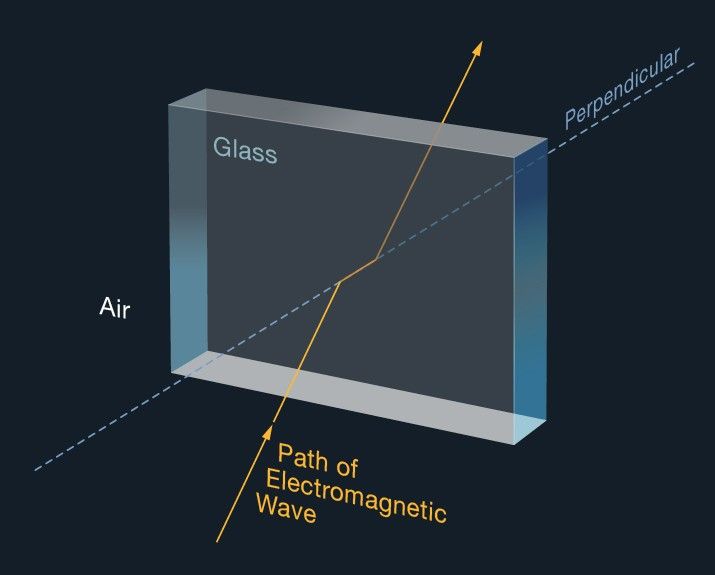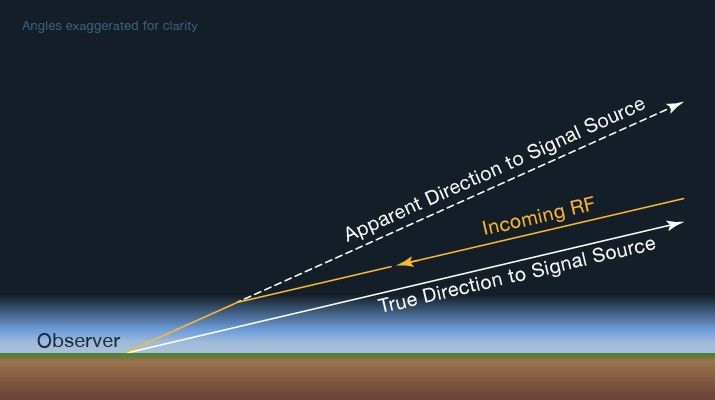Chapter 6: Electromagnetics
Page One | Page Two | Page Three | Page Four | Page Five | Page Six
Refraction
Refraction is the deflection or bending of electromagnetic waves when they pass from one kind of transparent medium into another.
The index of refraction of a material is the ratio of the speed of light in a vacuum to the speed of light in the material.
Electromagnetic waves passing from one medium into another of a differing index of refraction will be bent in their direction of travel. In 1621,
Dutch physicist Willebrord Snell (1591-1626), determined the angular relationships of light passing from one transparent medium to another.
Therefore, the path of electromagnetic waves moving from air to glass at an angle will be bent toward the perpendicular as they travel into the glass. Likewise, the path will be bent to the same extent away from the perpendicular when they exit the other side of glass.
Refraction is responsible for many useful devices that bend light in carefully determined ways, from eyeglasses to refracting telescope lenses.
Refraction can cause illusions. Spacecraft may appear to be in different locations in the sky than they really are.
Electromagnetic waves entering Earth's atmosphere from space are bent by refraction.
Atmospheric refraction is greatest for signals near the horizon where they come in at the lowest angle. The apparent altitude of the signal source can be on the order of half a degree higher than its true height.
As Earth rotates and the object gains altitude, the refraction effect reduces, becoming zero at the zenith (directly overhead).
Refraction's effect on the Sun adds about 5 minutes of time to the daylight at equatorial latitudes, since it appears higher in the sky than it actually is.
Refraction in Earth's Atmosphere
If the signal from a spacecraft goes through the atmosphere of another planet, the signals leaving the spacecraft will be bent by the atmosphere of that planet. This bending will cause the apparent occultation, that is, going behind the planet, to occur later than otherwise expected, and to exit from occultation prior to when otherwise expected. Ground processing of the received signals reveals the extent of atmospheric bending, and also of absorption at specific frequencies and other modifications. These provide a basis for inferring the composition and structure of a planet's atmosphere.
Phase
As applied to waves of electromagnetic radiation, phase is the relative measure of the alignment between two waveforms of similar frequency. They are said to be in phase if the peaks and troughs of the two waves match up with each other in time. They are said to be out of phase to the extent that they do not match up. Phase is expressed in degrees from 0 to 360.
The phase difference between two waves, or phase change in a single wave, can apply in different areas of interplanetary space flight. Phase shifts in a spacecraft's telecommunications radio signal can be employed to carry code. Observations of effects from the Sun (or other body) upon the phase (and other characteristics) of a radio signal can provide information about that body to radio scientists. Interactions between radio waves, or light waves, given their phase relationships, can also be useful in many ways.
Wave Interactions
Waves can interact with one another in various ways. For example, two incoming radio waves can augment one another, if they are in phase. If they are out of phase they can cancel each other out. Such interactions, and many other kinds, are involved variously in the business of interplanetary space flight: from scientific instruments aboard spacecraft that employ interferometers, to tracking antennas arrayed to increase the power of a spacecraft's radio signal being received, or ground-based telescopes that use interferometry to achieve enormous gains in resolution.
No further discussion of the physics of wave interaction is included here, but the subject can readily be researched via resources on the internet.



































